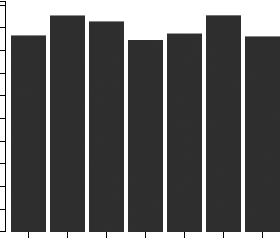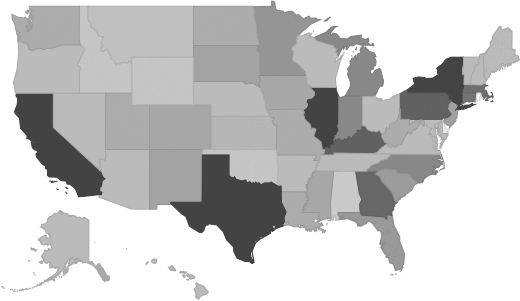Recreational and Vacation Camps (except Campgrounds) - Market Size, Financial Statistics, Industry Trends
Industry Overview
This U.S. industry comprises establishments primarily engaged in operating overnight recreational camps, such as childrens camps, family vacation camps, hunting and fishing camps, and outdoor adventure retreats, that offer trail riding, white water rafting, hiking, and similar activities. These establishments provide accommodation facilities, such as cabins and fixed campsites, and other amenities, such as food services, recreational facilities and equipment, and organized recreational activities. Illustrative Examples: Fishing camps with accommodation facilities Dude ranches Vacation camps (except campgrounds, day, instructional) Hunting camps with accommodation facilities Wilderness camps Outdoor adventure retreats with accommodation facilities Cross-References. Establishments primarily engaged in--Source: U.S. Census Bureau
Recreational and Vacation Camps (except Campgrounds) Market Size
This report includes historical and forecasted market sizes and industry trends for Recreational and Vacation Camps (except Campgrounds). It reveals overall market dynamics from 2020 through the present, and predicts industry growth or shrinkage through 2030. Revenue data include both public and private companies in the Recreational and Vacation Camps (except Campgrounds) industry.| Historical | Forecasted | ||||||||||
|---|---|---|---|---|---|---|---|---|---|---|---|
| 2020 | 2021 | 2022 | 2023 | 2024 | 2025 | 2026 | 2027 | 2028 | 2029 | 2030 | |
| Market Size (Total Revenue) | Included in Report |
||||||||||
| % Growth Rate | |||||||||||
| Number of Companies | |||||||||||
| Total Employees | |||||||||||
| Average Revenue per Company | |||||||||||
| Average Employees per Company | |||||||||||
Industry Revenue ($ Billions)

Industry Forecast ($ Billions)

Pell Research's advanced econometric models forecast five years of industry growth based on short- and long-term trend analysis. Market size statistics include revenue generated from all products and services sold within the Recreational and Vacation Camps (except Campgrounds) industry.
Geographic Breakdown by U.S. State
Recreational and Vacation Camps (except Campgrounds) market share by state pinpoints local opportunities based on regional revenue statistics. Growth rate for each state is affected by regional economic conditions. Data by state can be used to locate profitable and nonprofitable locations for Recreational and Vacation Camps (except Campgrounds) companies in the United States.Industry Revenue by State [Sample]

Distribution by Company Size
| Company Size | All Industries | Recreational and Vacation Camps (except Campgrounds) |
|---|---|---|
| Small Business (< 5 Employees) | Included |
|
| Small Business (5 - 20) | ||
| Midsized Business (20 - 100) | ||
| Large Business (100 - 500) | ||
| Enterprise (> 500) | ||
Industry Income Statement (Average Financial Metrics)
Financial statement analysis determines averages for the following industry forces:- Cost of goods sold
- Compensation of officers
- Salaries and wages
- Employee benefit programs
- Rent paid
- Advertising and marketing budgets
The report includes a traditional income statement from an "average" Recreational and Vacation Camps (except Campgrounds) company (both public and private companies are included).
| Industry Average | Percent of Sales | |
|---|---|---|
| Total Revenue | Included |
|
| Operating Revenue | ||
| Cost of Goods Sold (COGS) | ||
| Gross Profit | ||
| Operating Expenses | ||
| Operating Income | ||
| Non-Operating Income | ||
| Earnings Before Interest and Taxes (EBIT) | ||
| Interest Expense | ||
| Earnings Before Taxes | ||
| Income Tax | ||
| Net Profit | ||
Average Income Statement

Cost of Goods Sold
Salaries, Wages, and Benefits
Rent
Advertising
Depreciation and Amortization
Officer Compensation
Net Income
Financial Ratio Analysis
Financial ratios allow a company's performance to be compared against that of its peers.| Financial Ratio | Industry Average |
|---|---|
| Profitability Ratios | Included |
| Profit Margin | |
| ROE | |
| ROA | |
| Liquidity Ratios | |
| Current Ratio | |
| Quick Ratio | |
| Activity Ratios | |
| Average Collection Period | |
| Asset Turnover Ratio | |
| Receivables Turnover Ratio | |
| Inventory Conversion Ratio |
Compensation and Salary Surveys
Salary information for employees working in the Recreational and Vacation Camps (except Campgrounds) industry.| Title | Percent of Workforce | Bottom Quartile | Average (Median) Salary | Upper Quartile |
|---|---|---|---|---|
| Management Occupations | 7% |
Included |
||
| Chief Executives | 0% | |||
| General and Operations Managers | 4% | |||
| Food Preparation and Serving Related Occupations | 9% | |||
| Building and Grounds Cleaning and Maintenance Occupations | 17% | |||
| Building Cleaning and Pest Control Workers | 7% | |||
| Building Cleaning Workers | 7% | |||
| Grounds Maintenance Workers | 9% | |||
| Grounds Maintenance Workers | 9% | |||
| Landscaping and Groundskeeping Workers | 9% | |||
| Personal Care and Service Occupations | 16% | |||
| Other Personal Care and Service Workers | 11% | |||
| Recreation and Fitness Workers | 11% | |||
| Recreation Workers | 11% | |||
| Sales and Related Occupations | 6% | |||
| Retail Sales Workers | 5% | |||
| Office and Administrative Support Occupations | 21% | |||
| Information and Record Clerks | 9% | |||
| Hotel, Motel, and Resort Desk Clerks | 7% | |||
| Hotel, Motel, and Resort Desk Clerks | 7% | |||
| Other Office and Administrative Support Workers | 6% | |||
| Office Clerks, General | 6% | |||
| Office Clerks, General | 6% | |||
| Installation, Maintenance, and Repair Occupations | 14% | |||
| Other Installation, Maintenance, and Repair Occupations | 13% | |||
| Maintenance and Repair Workers, General | 13% | |||
| Maintenance and Repair Workers, General | 13% | |||
Government Contracts
The federal government spent an annual total of $3,372,417 on the Recreational and Vacation Camps (except Campgrounds) industry. It has awarded 142 contracts to 93 companies, with an average value of $36,263 per company.Top Companies in Recreational and Vacation Camps (except Campgrounds) and Adjacent Industries
| Company | Address | Revenue ($ Millions) |
|---|---|---|
Included |
||
